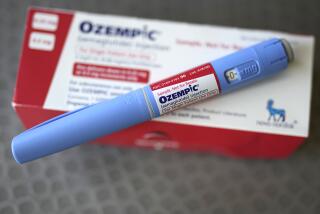Healthcare Watch: EPO health plans tightly restrict doctors that patients can see

Jay Pignatello of Manhattan Beach canceled his Blue Shield EPO health plan after finding out that it didn’t include doctors he assumed it would.
- Share via
Jay Pignatello thought he and his two children were adequately covered by his health plan. But when he put the policy to the test, he learned the hard way that they didn’t have the coverage he thought.
“Nothing was covered for me, nothing. Not prescriptions, my doctors, nothing,” says the 45-year-old management consultant from Manhattan Beach.
Pignatello had bought a policy from Blue Shield, a name he associated with broad access to doctors and hospitals throughout Los Angeles.
It turns out, however, that he was sold a kind of health plan that’s relatively new to most consumers called an exclusive provider organization, or EPO.
Not the preferred provider organization or PPO that Pignatello thought he was getting, this plan put much tighter restrictions on the doctors he could see — an important detail he didn’t realize.
“I didn’t even know what it was,” he said of an EPO health plan.
He’s not alone, says Nate Purpura, vice president of consumer affairs with online insurance broker eHealth.com.
“When people see EPOs online, they pick up the phone and call our call center because they want to know what an EPO is. It’s a question we get a lot these days,” Purpura says.
EPOs are a relatively new type of plan that limits coverage to in-network providers — except for medical emergencies. They are often considered hybrid insurance policies.
“Some may say an EPO is just a more flexible HMO plan,” says Michael Lujan, president of the California Assn. of Health Underwriters. Unlike an HMO, “you typically do not need a referral to see a specialist in an EPO plan.”
But the specialist has to be in your network. EPOs typically pay nothing if you see an out-of-network doctor.
Although EPOs still make up a small portion of all insurance policies being sold nationwide, they are fast becoming more common.
For 2016, consumers will find 60% more EPOs being sold through the federal insurance exchange, Healthcare.gov, than they did this year. They are also available in some cases to people who get their health benefits at work.
Their growing popularity has to do with efforts to control rising costs.
“Increasingly, health plans are trying to find ways to keep costs low but also drive value by incentivizing enrollees to seek care from specific providers,” says Elizabeth Carpenter, a vice president with the Washington, D.C.-based healthcare consulting firm Avalere.
But experts say that, like Pignatello, most people have never heard of an EPO or have any idea what they are or what the coverage means for them.
“Consumers are confused,” says Peter Lee, executive director for Covered California, the state’s health insurance exchange.
They think they’re in a PPO, he says, which allows members the flexibility to get care from doctors who don’t participate with their plan’s network. “But they’re actually in a plan that limits out-of-network care.”
“People think they’re getting a big network, everybody is in, and they have the ability to go out of network and have a lot of things covered,” Lee says.
That’s not the case. That’s in part why California has encouraged insurers to limit these plans for 2016 on the state’s health insurance exchange, and when they are made available, to market them very clearly to the public to avoid confusion.
In contrast to Healthcare.gov, Covered California is offering fewer EPOs for 2016 and 50% more PPOs — plans with out-of-network coverage — than were available this year.
Oscar Insurance Corp., an insurance start-up, is selling only EPOs in California. And that includes policies it is offering through Covered California in Orange County and part of Los Angeles County.
Experts outline a few important details to help evaluate EPOs, whether you buy insurance on your own or are offered one of these plans at work.
Expect access to a smaller network of providers. EPOs tend to have smaller networks and require you to see a participating doctor for your care to be covered.
“To get a relative sense of what this means in a large metropolitan market like Los Angeles, an EPO may include only 8% to 31% of the licensed physicians available,” Lujan says.
Look past the alphabet soup. No longer can you make assumptions about how much access you’ll have to doctors and hospitals in your area simply on the basis of plan type (HMO, PPO, EPO).
“I think the consumer generally feels like they prefer a PPO, but many people are confused about what the difference actually is,” says Dena Mendelsohn, an attorney with Consumers Union, the advocacy and policy division of Consumer Reports.
“It’s not surprising, because the differences between these plan types have really gotten blurred over the years,” she says.
Proceed with caution: The key to a good health plan, experts say, isn’t necessarily how large the network is, but rather whether the doctors and healthcare facilities you want and need are included.
No matter what type of plan you select, understanding the network, which providers participate and any restrictions is crucial.
Use available tools. The health insurance exchanges and many online insurance brokers, such as eHealth and Stride Health, as well as some employers offer tools that allow you to either link to each insurance carrier’s directory of doctors and hospitals or enter the name of your doctors to view only the plans they participate in.
Pignatello of Manhattan Beach has decided to drop his EPO policy and sign up for a new plan during the Affordable Care Act open-enrollment period now underway.
“After paying for two years $1,000 a month for three healthy people on a policy that didn’t cover anything,” he said, “I just woke up one day and I said I’ve had enough and terminated it.”
Twitter: @lisazamosky
More to Read
Inside the business of entertainment
The Wide Shot brings you news, analysis and insights on everything from streaming wars to production — and what it all means for the future.
You may occasionally receive promotional content from the Los Angeles Times.










